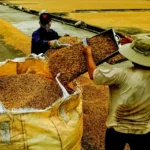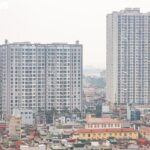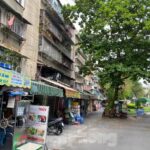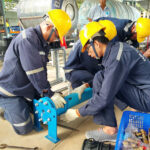On June 12, the National Assembly passed a resolution on the rearrangement of provincial-level administrative units for 2025. Accordingly, Ba Ria-Vung Tau, Binh Duong, and Ho Chi Minh City will merge to form a centrally-controlled city called Ho Chi Minh City. The political and administrative center will be located in District 1 of the current Ho Chi Minh City. The new Ho Chi Minh City will cover an area of 6,772.6 km2 and have a population of 13,608,800 people.
BOOSTING INFRASTRUCTURE INVESTMENT AFTER THE MERGER
Mr. Dinh Minh Tuan, Director of Batdongsan.com.vn in the Southern region, shared his thoughts following the historical resolution on the merger of provinces and cities. He believes that the new Ho Chi Minh City will be a “mega-city” with a strong development momentum.
According to Mr. Tuan, to maximize the potential of this mega-city, Ho Chi Minh City needs to develop a synchronized development strategy for each area. Ho Chi Minh City will be the center for finance, services, and innovation; Binh Duong will serve as the driving force for modern industrial development; and Ba Ria Vung Tau will be the gateway for international logistics and beach tourism.

Mr. Dinh Minh Tuan, Director of Batdongsan.com.vn in the Southern region
The director of Batdongsan.com.vn suggested six priorities that need to be implemented immediately after the merger:
Prioritize synchronized regional transportation connections: Accelerate key transportation projects such as the Ho Chi Minh City-Binh Duong metro line (expected to commence construction in 2027 and operate in 2031), the Ho Chi Minh City-Thu Dau Mot-Chon Thanh expressway, and the Can Gio-Vung Tau coastal road, including a sea-crossing bridge.
Additionally, construct a dedicated railway for container transportation from industrial parks in Binh Duong to the seaport in Ba Ria Vung Tau to optimize logistics. According to Mr. Tuan, currently, Ho Chi Minh City and Ba Ria Vung Tau do not have a direct road connection and have to go through Dong Nai province. Therefore, it is necessary to plan for a direct road connection to reduce travel time and costs.
To serve the purpose of population decentralization and reduce pressure on the central areas of Ho Chi Minh City, there is a need to develop public transportation, expand metro and inter-provincial bus lines, introduce water buses, and apply the TOD model to important stops.
Develop the Cai Mep-Can Gio cluster into an International Logistics Center: Reorganize the ports in Nha Be, Can Gio, and Cai Mep into a single linked system to avoid internal competition and optimize resources. Combine this with industrial parks in Binh Duong to connect to the global supply chain, where Binh Duong should take advantage of Ho Chi Minh City’s financial and banking services to support industrial parks and create an efficient supply chain.
Promote marine economy and tourism: Develop tourism products that connect Ho Chi Minh City (cultural and shopping tourism) with Vung Tau (beach tourism) and Con Dao (spiritual tourism), enhance promotion and connection to attract international and domestic tourists.
Develop high-tech industries and technology parks: According to Mr. Tuan, Binh Duong should continue to develop industrial parks and large-scale industrial parks, focusing on high-quality products such as semiconductors and artificial intelligence. Meanwhile, Ho Chi Minh City should focus more on financial services, technology, and high-quality human resource training. Transform Ho Chi Minh City into a center for science, technology, and innovation, combining industrial parks in Binh Duong with renewable energy in Ba Ria Vung Tau.
Plan and implement population decentralization: With a land area of up to 6,772 km2, there is sufficient space to develop multi-center urban areas and satellite cities to reduce pressure on central areas of Ho Chi Minh City, Di An, Thuan An, and Vung Tau.
Regarding population decentralization, three main tasks need to be accomplished: relocate important educational and healthcare facilities to the outskirts of Ho Chi Minh City; move industrial parks and financial centers from Ho Chi Minh City to satellite cities to reduce pressure; and plan land for the development of social housing and affordable housing in satellite cities.
Streamline the administrative apparatus after the merger: Establish coordinating agencies to ensure unity, implement a two-tier model, and streamline the apparatus with redundant positions, applying technology to reduce procedures for citizens.
OPTIMIZING THE USE OF URBAN LAND
Commenting on this historical move, Ms. Giang Huynh, Director of Research at Savills Ho Chi Minh City, emphasized that after the administrative merger, the new unit will still be named Ho Chi Minh City, becoming a mega-city in the Southeast region.
The political and administrative center of Ho Chi Minh City after the merger will be located in Ho Chi Minh City. Additionally, two auxiliary administrative centers will be maintained at the existing locations of the other two provinces. The merger will create a new economic and urban center with strong competitiveness, maximizing the natural advantages, geography, and infrastructure of the three localities.
The adjacent locations and well-connected transportation system between the three localities facilitate efficient and effective urban and economic space planning. The expanded land area provides opportunities for population decentralization strategies, the development of satellite cities, and the construction of modern new urban areas. Additionally, the synchronized transportation infrastructure, especially the road, waterway, and seaport systems, will enhance regional connectivity and improve logistics capabilities.

Ms. Giang Huynh, Director of Research, Savills Ho Chi Minh City
According to Ms. Giang, to ensure the sustainability and optimization of urban land use in the administrative merger process, four key factors need to be addressed simultaneously.
First is administrative and land procedures, which involve reviewing and simplifying procedures related to administration and land.
Second is the master plan, which entails developing a unified plan for both land and infrastructure.
Third is the financial mechanism, which involves establishing an efficient public investment disbursement mechanism for infrastructure.
Finally, a clear common development strategy is essential.
The Savills expert analyzed that the merger of these three areas creates a large and diverse economic region, encompassing industries such as industry, residential, commercial services, and tourism. To realize its full potential, it is crucial to implement a synchronized planning strategy and efficient administrative procedures.
Currently, the infrastructure connectivity between Ho Chi Minh City, Binh Duong, and Ba Ria-Vung Tau is limited. Despite the presence of major national highways and the Ho Chi Minh City-Long Thanh expressway (soon to be Ho Chi Minh City-Thu Dau Mot and Bien Hoa-Vung Tau), traffic congestion persists, especially at critical intersections like An Phu roundabout, with the potential to spread to neighboring areas like Long Thanh.
“The timely completion of key infrastructure projects such as Ring Road 3 and the Ho Chi Minh City-Thu Dau Mot and Bien Hoa-Vung Tau expressways is crucial to alleviating congestion on existing roads and unlocking the potential of peripheral areas awaiting infrastructure development. Additionally, future infrastructure planning should include new solutions for more effective connections between Ho Chi Minh City, Binh Duong, Ba Ria-Vung Tau, and other neighboring areas like Dong Nai,” emphasized Ms. Giang.
OPPORTUNITIES FOR THE REAL ESTATE MARKET
Sharing his insights on the opportunities for the real estate market following the merger, Mr. Tran Khanh Quang, CEO of Vietnam An Hoa Real Estate Investment Joint Stock Company, stated that the new Ho Chi Minh City will witness remarkable development, comparable to major global cities, by combining industry, services, and seaports.
Mr. Quang pointed out that there are currently two investment trends in the real estate market. The first is the trend towards apartment living. In the next three years, this will be the market trend. The second trend is modern urban areas.

Mr. Tran Khanh Quang
According to Mr. Quang, the real estate market has recovered since 2024, but the signals have not been clear due to difficulties in handling inventory. When selling, although projects are heavily promoted by investors, the actual transaction volume is very low.
In 2025, the market has entered a new phase and started to develop steadily. “The market in 2025-2026 will return with positive signals,” Mr. Quang emphasized.
Ms. Pham Thi Mien, Deputy Director of the Vietnam Real Estate Market Research Institute (VARS IRE), stated that currently, real estate prices in Binh Duong and Ba Ria Vung Tau are 20-30% lower than in Ho Chi Minh City, but they still benefit from the shared ecosystem. In particular, the unification of planning and investment procedures helps resolve legal issues, accelerate project implementation, attract capital and high-quality residents, and boost the housing market.
After the merger, real estate prices in the regions tend to increase. According to VARS data, real estate prices in Ba Ria-Vung Tau increased by 5-8% compared to the end of 2024. Meanwhile, apartment prices in Ho Chi Minh City rose by about 13-15% compared to last year. The average increase in Binh Duong was around 10% compared to the same period.
Ms. Cao Thi Thanh Huong, Senior Manager of the Research Department at Savills Ho Chi Minh City, opined that the merger to form a mega-city would streamline administrative procedures, making it easier for businesses to develop projects by eliminating the district and provincial levels. The expansion of social housing eligibility to include non-locals, along with the abundant land supply from neighboring provinces, contributes to addressing the housing shortage. However, this is not a sufficient factor. The new land fund needs to be accompanied by infrastructure development that connects to the city center and other developed areas.
According to experts, with the expanded development space and strong transportation infrastructure investment, the real estate market will benefit, leading to increased demand for capital and credit. However, as the network of credit institutions already covers the whole country, the redistribution of capital is not a decisive factor. It is essential that projects are feasible and meet the requirements and principles of credit for capital efficiency.
The Online Grocery Conundrum
“In an interview with Tien Phong newspaper regarding the complex issue of unsafe and low-quality food, Mr. Nguyen Quang Huy, Deputy Head of the Ho Chi Minh City Market Management Department, stated that the range of violating products is diverse. It spans from fresh produce and ready-to-eat meals to sugar, bird’s nest, and dietary supplements.”
The City of Ho Chi Minh Introduces a 7-Step Renovation Process for Old Apartment Buildings
The Ho Chi Minh City authorities are taking proactive steps to reinvigorate development projects by introducing a competitive bidding process. This process will identify and select new investors with the requisite capabilities to replace those who are no longer legally compliant or have delayed implementation, especially in projects undertaken or previously ceded by state-owned enterprises.
The Rise of a New Property Powerhouse: Unveiling the Southern Market’s Next Boom Cycle
Bình Dương has emerged as a Southern “hotspot”, strategically poised with advantageous connectivity and a thriving real estate market that outshines its neighbors.














































